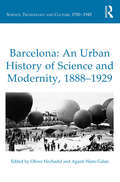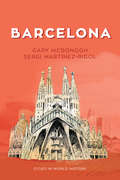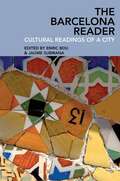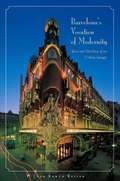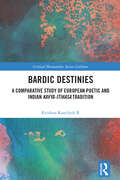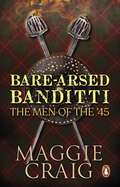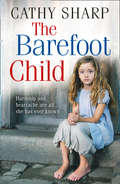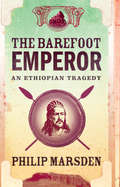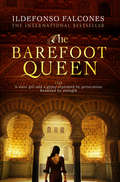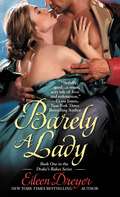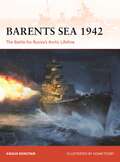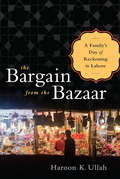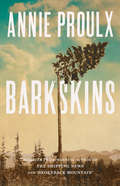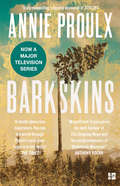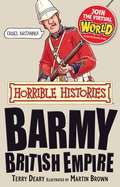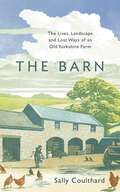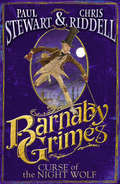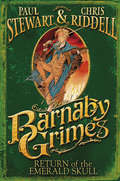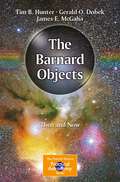- Table View
- List View
Barcelona: An Urban History Of Science And Modernity, 1888-1929 (Science, Technology and Culture, 1700-1945)
by Oliver Hochadel Agustí Nieto-GalanThe four decades between the two Universal Exhibitions of 1888 and 1929 were formative in the creation of modern Barcelona. Architecture and art blossomed in the work of Antoni Gaudi and many others. At the same time, social unrest tore the city apart. Topics such as art nouveau and anarchism have attracted the attention of numerous historians. Yet the crucial role of science, technology and medicine in the cultural makeup of the city has been largely ignored. The ten articles of this book recover the richness and complexity of the scientific culture of end of the century Barcelona. The authors explore a broad range of topics: zoological gardens, natural history museums, amusement parks, new medical specialities, the scientific practices of anarchists and spiritists, the medical geography of the urban underworld, early mass media, domestic electricity and astronomical observatories. They pay attention to the agenda of the bourgeois elites but also to hitherto neglected actors: users of electric technologies and radio amateurs, patients in clinics and dispensaries, collectors and visitors of museums, working class audiences of public talks and female mediums. Science, technology and medicine served to exert social control but also to voice social critique. Barcelona: An urban history of science and modernity (1888-1929) shows that the city around 1900 was both a creator and facilitator of knowledge but also a space substantially transformed by the appropriation of this knowledge by its unruly citizens.
Barcelona: A Social History Of Power In The Industrial Era (Cities in World History #471)
by Gary McDonogh Sergi Martinez-RigolBarcelona has existed as a settlement for two millennia. Early civilizations shaped the city before it achieved, in the Middle Ages and Renaissance, global power as a trading metropolis and empire capital. After a long struggle with the unifying Spanish state, the city revived, in the eighteenth and nineteenth centuries, as an industrial and commercial powerhouse. It became a center of culture, ornamented by modern planning and wondrous works by Gaudí and others. Barcelona became known as “The Rose of Fire”: home to revolutionaries and anarchists. Creativity and conflict continued to shape Barcelona in the twentieth century, as its citizens faced the Spanish Republic, Civil War and Franco’s dictatorship. Linking social and cultural currents to the rich architectural and experiential heritage of this multi-layered city, McDonogh and Martínez-Rigol reveal Barcelona’s hidden history to modern-day visitors and residents alike.
The Barcelona Reader: Cultural Readings of a City
by Enric Bou Jaume SubiranaOver the last twenty years there has been a growing international interest in the city of Barcelona. This has been reflected in the academic world through a series of studies, courses, seminars, and publications. The Barcelona Reader hinges together a selection of the best academic articles, written in English, about the city, and its main elements of identity and interest: art, urban planning, history and social movements. The book includes scholarly essays about Barcelona that can be of interest to the student and the general public alike. It focuses on cultural representations of the city: the arts (including literature) provide a complex yet discontinuous portrait of the city, similar to a patchwork. The authors selected create a kaleidoscope of views and voices thus presenting a diverse yet inclusive Barcelona portrait. The Barcelona Reader offers a multifaceted assessment that will be essential reading for anyone interested in this iconic city.
The Barcelona Reader: Cultural Readings of a City
by Enric Bou and Jaume SubiranaOver the last twenty years there has been a growing international interest in the city of Barcelona. This has been reflected in the academic world through a series of studies, courses, seminars, and publications. The Barcelona Reader hinges together a selection of the best academic articles, written in English, about the city, and its main elements of identity and interest: art, urban planning, history and social movements. The book includes scholarly essays about Barcelona that can be of interest to the student and the general public alike. It focuses on cultural representations of the city: the arts (including literature) provide a complex yet discontinuous portrait of the city, similar to a patchwork. The authors selected create a kaleidoscope of views and voices thus presenting a diverse yet inclusive Barcelona portrait. The Barcelona Reader offers a multifaceted assessment that will be essential reading for anyone interested in this iconic city.
Barcelona: An Urban History of Science and Modernity, 1888-1929 (Science, Technology and Culture, 1700-1945)
by Oliver Hochadel Agustí Nieto-GalanThe four decades between the two Universal Exhibitions of 1888 and 1929 were formative in the creation of modern Barcelona. Architecture and art blossomed in the work of Antoni Gaudi and many others. At the same time, social unrest tore the city apart. Topics such as art nouveau and anarchism have attracted the attention of numerous historians. Yet the crucial role of science, technology and medicine in the cultural makeup of the city has been largely ignored. The ten articles of this book recover the richness and complexity of the scientific culture of end of the century Barcelona. The authors explore a broad range of topics: zoological gardens, natural history museums, amusement parks, new medical specialities, the scientific practices of anarchists and spiritists, the medical geography of the urban underworld, early mass media, domestic electricity and astronomical observatories. They pay attention to the agenda of the bourgeois elites but also to hitherto neglected actors: users of electric technologies and radio amateurs, patients in clinics and dispensaries, collectors and visitors of museums, working class audiences of public talks and female mediums. Science, technology and medicine served to exert social control but also to voice social critique. Barcelona: An urban history of science and modernity (1888-1929) shows that the city around 1900 was both a creator and facilitator of knowledge but also a space substantially transformed by the appropriation of this knowledge by its unruly citizens.
Barcelona's Vocation of Modernity: Rise and Decline of an Urban Image
by Joan Ramon ResinaSince the closing decades of the nineteenth century, Barcelona has striven to sustain an image of modernity that distinguishes itself within Spain. Barcelona's Vocation of Modernity traces the development of that image through texts that foreground key social and historical issues. It begins with Barcelona's "coming of age" in the 1888 Universal Exposition and focuses on the first major narrative work of modern Catalan literature, La febre d'or. Positing an inextricable link between literature and modernity, Resina establishes a literary framework for the evolution of the image of Barcelona's modernity through the 1980s, when the consciousness of modernity took on an ironic circularity. Because the city is an aggregation of knowledge, Resina draws from sociology, urban studies, sociolinguistics, history, psychoanalysis, and literary history to produce a complex account of Barcelona's self-reflection through culture. The last chapter offers a glimpse into the "post-historical" city, where temporality has been sacrificed to the spatialization associated with the seductions of the spectacle.
Bardic Destinies: A Comparative Study of European Poetic and Indian Kavya-Itihasa Tradition (Critical Humanities Across Cultures)
by Krishna R. KanchithThis volume critically explores the cultural significance and fate of the “literary” in the European and the Indian traditions as it traces the history of the reception of works that have had a deep hold on the lives and sensibilities of people across time and cultures. The book grapples with three major concepts in the humanities—the literary, the philosophical/theological and the historical. It looks at Homer’s reception by Plato; Virgil’s reception by Christianity; the many responses that The Mahabharata has received over centuries and across cultures in India; and the reception of Kumaravyasa’s Kumaravyasabharata, among other works, and analyses the understanding of truth, time and history that influence the reading of these works in different times and cultural contexts. Part of the Critical Humanities across Cultures series, this book will be useful for scholars and researchers of philosophy, literature, history, comparative literature, cultural studies and post-colonial studies.
Bardic Destinies: A Comparative Study of European Poetic and Indian Kavya-Itihasa Tradition (Critical Humanities Across Cultures)
by Krishna R. KanchithThis volume critically explores the cultural significance and fate of the “literary” in the European and the Indian traditions as it traces the history of the reception of works that have had a deep hold on the lives and sensibilities of people across time and cultures. The book grapples with three major concepts in the humanities—the literary, the philosophical/theological and the historical. It looks at Homer’s reception by Plato; Virgil’s reception by Christianity; the many responses that The Mahabharata has received over centuries and across cultures in India; and the reception of Kumaravyasa’s Kumaravyasabharata, among other works, and analyses the understanding of truth, time and history that influence the reading of these works in different times and cultural contexts. Part of the Critical Humanities across Cultures series, this book will be useful for scholars and researchers of philosophy, literature, history, comparative literature, cultural studies and post-colonial studies.
Bare-Arsed Banditti: The Men of the '45
by Maggie CraigThey were modern men: doctors and lawyers, students and teachers, shoemakers and shopkeepers, farmers, gardeners and weavers. Children of the Age of Reason, they wrote poetry, discussed the latest ideas in philosophy and science - and rose in armed rebellion against the might of the British crown and government.Sons of a restless nation that had unwillingly surrendered its independence a mere generation before, some were bound by age-old ties of Highland kinship and loyalty. Others rallied to the cries of 'Prosperity to Scotland' and 'No Union!'Many faced agonising personal dilemmas before committing themselves to Bonnie Prince Charlie and the Jacobite Cause. Few had any illusions about the consequences of failure. Many met their date with destiny on Culloden Moor, players in a global conflict that shaped the world we live in today.Combining meticulous research with entertaining and stylish delivery, Maggie Craig tells the dramatic and moving stories of the men who were willing to risk everything for their vision of a better future for themselves, their families and Scotland.
The Barefoot Child (The Children of the Workhouse #2)
by Cathy SharpThe heart-breaking and compelling new book set in a Victorian workhouse from the author of the The Orphans of Halfpenny Street
The Barefoot Emperor: An Ethiopian Tragedy
by Philip MarsdenA fascinating narrative excursion into a bizarre episode in 19th century Ethiopian and British imperial history, featuring a remote African despot and his monstrous European-built gun.
The Barefoot Queen
by Ildefonso Falcones1748, Seville: Caridad, a recently freed Cuban slave, wanders the streets of the city. Her master is dead and she has nowhere to go. When she meets Milagro Carmona - a young, rebellious gypsy - the two women are instantly inseparable. Milagros introduces Caridad to the gypsy community, an exotic fringe society that will soon bring them love and change their life forever.From the tumultuous bustle of 18th-century Seville to the theatres of Madrid, THE BAREFOOT QUEEN takes us into the murky world of tobacco smuggling and ther persecution of the gypsies. Showing us the birth of Flamenco, it is a historical fresco filled with characters that live, love, fight and suffer for what they believe.
Barely a Lady (Drake's Rakes #1)
by Eileen DreyerOlivia Grace has secrets that could destroy her. One of the greatest of these is the Earl of Gracechurch, who married and divorced her five years earlier. Abandoned and disgraced, Grace has survived those years at the edge of respectability. Then she stumbles over Jack on the battlefield of Waterloo, and he becomes an even more dangerous secret. For not only is he unconscious, he is clad in an enemy uniform.But worse, when Jack finally wakes in Olivia's care, he can't remember how he came to be on a battlefield in Belgium. In fact, he can remember nothing of the last five years. He thinks he and Olivia are still blissfully together. To keep him from being hanged for a traitor, Olivia must pretend she and Jack are still married. To unearth the real traitors, Olivia and Jack must unravel the truth hidden within his faulty memory. To save themselves and the friends who have given them sanctuary, they must stand against their enemies, even as they both keep their secrets.In the end, can they risk everything to help Jack recover his lost memories, even though the truth may destroy them both?
Barents Sea 1942: The Battle for Russia’s Arctic Lifeline (Campaign)
by Angus KonstamA gripping examination of the Battle of the Barents Sea, fought in the near darkness and icy cold of the northern winter, in which the Kriegsmarine sought to sever the crucial Allied Arctic Convoy route once and for all.The Arctic convoys that passed through the cold, dangerous waters of the Barents Sea formed a vital lifeline – a strategic link in tanks, supplies and above all goodwill between the Western Allies and the Soviet Union. In December 1942, under Operation Regenbogen (Rainbow), the German Kriegsmarine sought to strike a crippling blow on the Arctic convoys and finally sever this all-important sea route. In this fascinating work, renowned naval expert Angus Konstam documents the fate of the Allied Convoy JW 51B as it came under attack from some of the Kriegsmarine's most powerful surface warships – a pocket battleship, a heavy cruiser and six destroyers. Illustrated with stunning battlescene artworks, maps, 3D diagrams and photographs, it explores the David and Goliath struggle between the Allied ships defending the convoy and the powerful German force, until the arrival of the two British cruisers tipped the balance of power. The Battle of the Barents Sea, fought amid snowstorms and the darkness of the Arctic night, would prove to be a turning point in the hard-fought war in northern waters, and would test Hitler's patience with his surface fleet to the limit.
Barents Sea 1942: The Battle for Russia’s Arctic Lifeline (Campaign)
by Angus KonstamA gripping examination of the Battle of the Barents Sea, fought in the near darkness and icy cold of the northern winter, in which the Kriegsmarine sought to sever the crucial Allied Arctic Convoy route once and for all.The Arctic convoys that passed through the cold, dangerous waters of the Barents Sea formed a vital lifeline – a strategic link in tanks, supplies and above all goodwill between the Western Allies and the Soviet Union. In December 1942, under Operation Regenbogen (Rainbow), the German Kriegsmarine sought to strike a crippling blow on the Arctic convoys and finally sever this all-important sea route. In this fascinating work, renowned naval expert Angus Konstam documents the fate of the Allied Convoy JW 51B as it came under attack from some of the Kriegsmarine's most powerful surface warships – a pocket battleship, a heavy cruiser and six destroyers. Illustrated with stunning battlescene artworks, maps, 3D diagrams and photographs, it explores the David and Goliath struggle between the Allied ships defending the convoy and the powerful German force, until the arrival of the two British cruisers tipped the balance of power. The Battle of the Barents Sea, fought amid snowstorms and the darkness of the Arctic night, would prove to be a turning point in the hard-fought war in northern waters, and would test Hitler's patience with his surface fleet to the limit.
The Bargain from the Bazaar: A Family's Day of Reckoning in Lahore
by Haroon K. UllahAwais Reza is a shopkeeper in Lahore's Anarkali Bazaar-the largest open market in South Asia-whose labyrinthine streets teem with shoppers, rickshaws, and cacophonous music.But Anarkali's exuberant hubbub cannot conceal the fact that Pakistan is a country at the edge of a precipice. In recent years, the easy sociability that had once made up this vibrant community has been replaced with doubt and fear. Old-timers like Awais, who inherited his shop from his father and hopes one day to pass it on to his son, are being shouldered aside by easy money, discount stores, heroin peddlers, and the tyranny of fundamentalists.Every night before Awais goes to bed, he plugs in his cell phone and hopes. He hopes that the city will not be plunged into a blackout, that the night will remain calm, that the following morning will bring affluent and happy customers to his shop and, most of all, that his three sons will safely return home. Each of the boys, though, has a very different vision of their, and Pakistan's, future.The Bargain from the Bazaar-the product of eight years of field research-is an intimate window onto ordinary middle-class lives caught in the maelstrom of a nation falling to pieces. It's an absolutely compelling portrait of a family at risk-from a violently changing world on the outside and a growing terror from within.
Barkskins: A Novel
by Annie ProulxLONGLISTED FOR THE BAILEYS WOMEN’S PRIZE FOR FICTION 2017 A NEW YORK TIMES BOOK OF THE YEAR From Annie Proulx, the Pulitzer Prize-winning author of The Shipping News and Brokeback Mountain, comes her masterwork: an epic, dazzling, violent, magnificently dramatic novel about the taking down of the world’s forests.
Barkskins: A Novel
by Annie ProulxLONGLISTED FOR THE BAILEYS WOMEN’S PRIZE FOR FICTION 2017 A NEW YORK TIMES BOOK OF THE YEAR From Annie Proulx, the Pulitzer Prize-winning author of The Shipping News and Brokeback Mountain, comes her masterwork: an epic, dazzling, violent, magnificently dramatic novel about the taking down of the world’s forests.
Barmy British Empire (Horrible Histories Ser.)
by Terry Deary Martin BrownFor centuries, the barmy Brits bounded round the globe, conquering other countries in the name of their Empire. From infamous India to dreadful deeds down under, brutal Britannia ruled the land and waves. Are you ready for some horrible Empire-grabbing action? Then find out... · How a war started when a Brit insisted on sitting on a stool · Who wore a necklace made of 50 human skulls · Why a British soldier used his own coffin as a wardrobe! From savage slavers and rotten rebels to horrible heroes and nasty natives, grab the foul facts about the Barmy British Empire - with all the gore and more!
The Barn: The Lives, Landscape and Lost Ways of an Old Yorkshire Farm
by Sally CoulthardA revelatory uncovering of a vanished agricultural way of life by bestselling nature writer Sally Coulthard. 'A gem of a book' Country Smallholding 'Engaging and filled with gentle humour and fascinating facts' Get History 'Shows us the beauty and rich history of everyday things' Country Walking MagazineAcross the foldyard from Sally Coulthard's North Yorkshire farmhouse, stands an old stone barn. When she discovered a set of witches' marks on one of its internal walls, she began to wonder about the lives of the people who had once lived and worked there.Both the intimate story of a building and its hinterland, and a wider social history, The Barn explores a hidden corner of rural Britain that has witnessed remarkable changes. From the eighteenth-century Enclosures to the Second World War, the fortunes of the Barn have been blown, like a leaf in a gale, by the unstoppable forces of new agriculture and industry. Seismic shifts in almost every area of society were all played out here in miniature – against a backdrop of scattered limestone villages and the softly rolling Howardian Hills.
Barnaby Grimes: Curse Of The Night Wolf (Barnaby Grimes #1)
by Chris Riddell Paul StewartBarnaby Grimes is a tick-tock lad, running errands in his city, day and night, and 'high-stacking' around the rooftops in search of new mysteries to solve. In this first adventure, Barnaby is attacked one night by an enormous dog. He kills it - but that's not the end of this particular mystery . . . as Barnaby finds himself swept up in a world of crooked doctors, poor and ill-advised patients, strange tonics and very expensive furs... Could there be more to the seemingly respectable Dr Cadwallader and the tonics he doles out to the poor? Is there a link between the tonic and the huge dogs - or possibly wolves - that are roaming the city at night? When Barnaby's old acquaintance Benjamin goes missing, Barnaby fears the worst for him, and decides to dig deeper... A fantastic romp through a Dickensian-style city, with a wonderful new hero in the guise of Barnaby. This new series from the bestselling dream team of Stewart and Riddell is a must for all fans of the Edge Chronicles - but also for fans of Horowitz and Shan, as they move into new territory and deliver a brilliantly exciting thriller-horror for boys.
Barnaby Grimes: Barnaby Grimes (Barnaby Grimes #2)
by Chris Riddell Paul StewartBarnaby Grimes is a tick-tock lad, running errands in his city, day and night, and high-stacking around the rooftops in search of new mysteries to solve. A fantastic romp through a Dickensian-style city, with a wonderful new hero in the guise of Barnaby. After collecting a strange parcel from a deserted ship in the fog of the docks, and delivering it to the local schoolmaster, Barnaby thinks he's earned a moment to sit on the rooftops and eat his favourite pasty. But soon he realises that all is not well at the school - but is the problem quite as he expects it? A gruesome tale of a school overrun by a terrible curse - who will survive?
The Barnard Objects: Then and Now (The Patrick Moore Practical Astronomy Series)
by Tim B. Hunter Gerald O. Dobek James E. McGahaThe Barnard Objects have fascinated professional and amateur astronomers for over one hundred years. Many of those objects first imaged by E.E. Barnard on black-and-white photographic plates are now being captured daily in thousands of color astrophotographs. This book tells of Barnard’s story; describing his life and work as well as how the fields of astronomy and astrophotography have transformed ever since.The chapters in this book are equal parts history and science. It will provide readers with an introduction to nebula science and the incredible discoveries made in this field over the decades; including an overview of popular astronomical catalogues and a detailed look at how astronomical imaging has advanced since Barnard’s time, from early plates to digital imaging and chips. In addition, the book features a comprehensive guide to viewing and imaging these objects yourself. A glossary of astronomical and photographic terms is provided, along with detailed references. And, an updated table displaying the locations of these Barnard Objects; including the missing twenty-five objects from E.E. Barnard’s original catalogue.Richly researched and illustrated, this fascinating reference will attract astronomers of all skill levels interested in astrophotography and how it has changed over the past hundred years.
